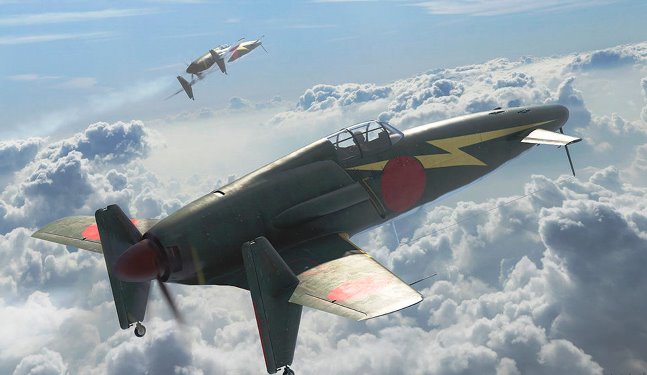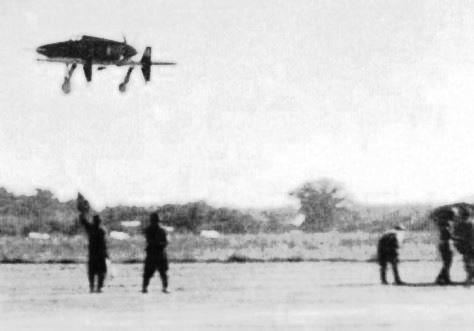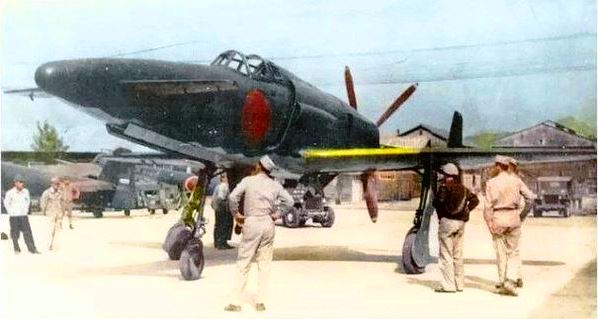Kyushu J7W1 canard-configured interceptor
 (J7W1 painting by Antonis Karidis)
(J7W1 painting by Antonis Karidis)
Imperial Japanese Navy J7W Shinden ("Magnificent Lightning") - 1943-1945
© 2018 Bob Hackett
April 1943:
The J7W1 fighter design is devised by Captain Tsuruno Massaoki, a member of the technical staff of the Imperial Japanese Navy. It is first envisioned as a jet-powered interceptor to counter American B-29 "Superfortress" high-altitude bombers. The "J" designation of J7W1 refers to land-based fighters of the IJN and the "W" to Watanabe Tekkojo, the company that oversees the initial design. In 1943, Watanabe changes its name to Kyushu Hikoki, K.K.
The original idea for the Shinden is as a jet powered aircraft, but a six-bladed propeller is installed instead in the rear of the aircraft. The large propeller needs an unusually long tricycle landing gear. It will have four 30mm cannon installed in the front to balance the heavy engine in the back. The J7W1 Shinden is also designed to be retrofitted with a turbojet engine as this technology matured.
Tsuruno's idea is presented to the First Naval Air Technical Arsenal and accepted for development. Three evaluation glider models are developed and constructed under the collective designation of MXY6. These systems prove vital in validating the handling capabilities of a canard-based design and one is even fitted with a single Ha-90 series 4-cylinder 22 horsepower air-cooled engine. Testing starts in 1943 and proves the design sound.
The J7W1 Shinden is the only aircraft with a canard layout to be ordered in quantity production during WWII. It is one of the most unusual aircraft to be designed in Japan. The rear-mounted radial engine is a pusher design, although in the next version it is planned that the piston engine will be replaced with a 900 kg thrust Ne-130 turbojet. The Navy supports the J7W project as it desperately needs a heavily-armed high-performance interceptor fighter.
4 June 1944:
Zasshonokuma, Fukuoka. Construction of the first two JW1 short-range interceptor fighter prototypes begins at the Kyushu aircraft factory.
January 1945:
Stress calculations are completed, and within a short 10 month period, the first Shinden prototype is completed in April 1945. The Japanese Navy orders production to commence.
3 August 1945:
Itazuke Airfield, Fukuoka. After addressing engine overheating issues, Captain Tsuruno pilots the first prototype aircraft on its maiden flight. It takes to the air two more times and nets a total of just 45 minutes flight time. A second prototype under construction is never to fly.
 Prototype Shinden coming in for landing after flight test.
A production contract is signed with high expectations. However, the American atomic bombing of Hiroshima on 6 August and Nagasaki on 9 August - ends all hopes for the Shinden.
15 August 1945:
Prototype Shinden coming in for landing after flight test.
A production contract is signed with high expectations. However, the American atomic bombing of Hiroshima on 6 August and Nagasaki on 9 August - ends all hopes for the Shinden.
15 August 1945:
The war ends before production can began.
 J7W1 on the ramp postwar.
J7W1 on the ramp postwar.
-Bob Hackett
Back to the IJNAF Page







